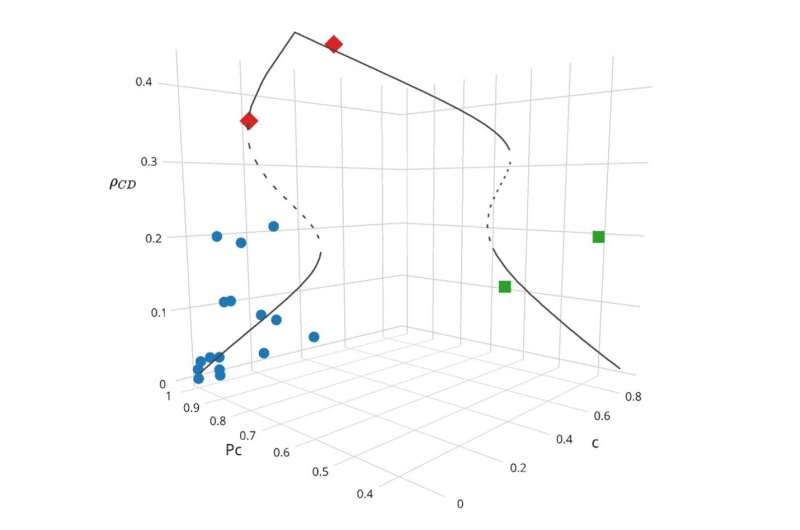May 30, 2017 feature
Phase transitions of rice farmers may offer insight into managing natural resources

(Phys.org)—The Balinese subak is a self-organized agrarian society on the island of Bali in Indonesia, whose members must share a limited amount of water for irrigation and rice production. Some of the farmers share the water fairly, and some don't. As in many societies, the members of the Balinese subak are segregated into different communities.
Now in a new study, scientists have found that this segregation changes a society's cooperation dynamics and may help to promote cooperation and fair resource utilization at the societal level. The results have implications for managing natural resources, which is of particular relevance for addressing environmental issues such as curbing pollution, reducing deforestation, and saving endangered species—problems that require widespread cooperation.
The researchers, H. S. Sugiarto et al., from Nanyang Technological University in Singapore, the National University of Singapore, and other institutions, have published their results in a recent issue of Physical Review Letters.
In their study, the researchers developed a model of social cooperation in self-organized societies that lack central governance, in which individuals are free to choose whether to abide by the rules or not. Their model shows that, as a shared resource becomes more abundant, more individuals may shift from being cooperators (who follow the rules) to being defectors (who violate the rules). At some point, the resource becomes so abundant that all individuals become defectors and social cooperation vanishes.
Then the researchers looked at the same scenario, but this time they allowed the society to self-segregate into smaller communities. They found that the downside of the segregation is that it increases the social disharmony throughout the society as a whole. The upside, however, is that the social disharmony within each community becomes very low. In some communities, individuals are more likely to keep cooperating with each other—using the shared resource fairly—compared to the situation without segregation. These results were very similar to what the researchers observed in the segregated society of the Balinese subak.
As the researchers explained, the results can be understood in terms of phase transitions. While phase transitions are common in many areas of physics, their role in complex systems, such as human societies, is a newer area of research. In the current study, the shift from cooperators to defectors in a society without segregation as the resource becomes more abundant represents an abrupt phase transition. The researchers explain that segregation "softens" this transition by replacing it with multiple intermediate phases, which arise because some communities are full of cooperators while others are full of defectors.
"The greatest significance of our work is in the revelation that stable phases of social and ecological regimes do exist in real-world systems," coauthor Lock Yue Chew, an associate professor at Nanyang Technological University, told Phys.org. "Our work has also developed mechanistic insights that address a vital question in social science through a more fine-grained and realistic application of ideas from physics."
In the future, the researchers plan to investigate how these results can help improve cooperative behavior in the real world, in order to better manage natural resources.
"Our results are relevant to applications where the induction of cooperative social behavior is the primary approach to managing the sustainable use of limited natural resources in the context of coupled human-natural systems," Chew said. "Potential systems of interest include the forest system, fisheries system, and many others, in addition to the rice production system of Bali in our paper."
Building on these results, in an upcoming paper the researchers report on how stress from pest infestation can affect rice growth, and how it can lead to an optimality in the farmers' payoff. This work is scheduled to appear in the June 2017 issue of PNAS.
More information: H. S. Sugiarto et al. "Social Cooperation and Disharmony in Communities Mediated through Common Pool Resource Exploitation." Physical Review Letters. DOI: 10.1103/PhysRevLett.118.208301
Journal information: Physical Review Letters , Proceedings of the National Academy of Sciences
© 2017 Phys.org





















